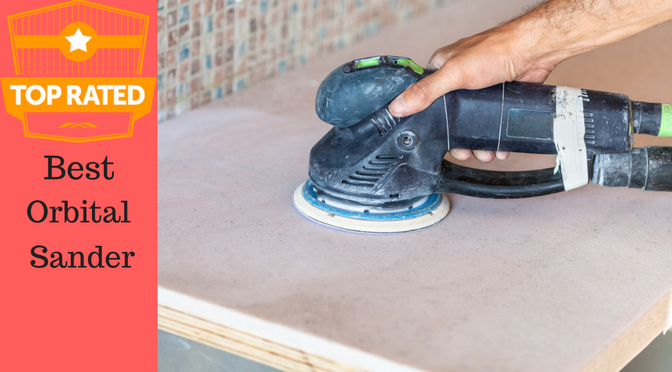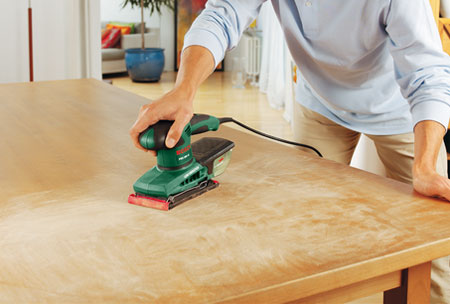How To Pick The Best Orbital Sander

Sanding is one of the most tedious tasks in any construction work or DIY project. However, with the right set of tools such as an electric power sander, this task can be accomplished fast and effectively. The goal in finding an electric power sander is to choose the one that will provide a smooth and flawless finish that will not damage the workpiece. Thus, you must consider the best orbital sander, which is a lightweight yet effective tool.
An orbital finishing sander is also called a quarter-sheet sander due to the fact that it accepts a quarter of a sheet of the standard sandpaper. It has become one of the most common hand tools used in shops and homes because of its convenience and affordable price.
Product name | quality | price | our rating |
|---|---|---|---|
A+ | $$ | ||
A+ | $ | ||
A | $ | ||
A | $ | ||
A | $ |
How Orbital Sanders Work

Orbital sanders require round disks of sandpaper, which are attached to the base of the unit using an adhesive or a hook-and-loop fastener. The motor of the orbital sander moves in a random motion. An offset drive bearing allows the pad to move following an elliptical pattern. The randomness of the movement prevents swirls from being left behind.
Benefits of Using Orbital Sanders
One of the major benefits of using orbital sanders is its superior capacity in removing any material. Because of its random motion patterns, it does not leave any swirls and thus results to a smooth finish. To achieve good results, changing grits is not necessitated, which translates to less hassle alongside the easily changeable hook-and-loop disks. Comfort is not an issue with this sander since it is lighter than other types of sanding tools. Thus, you will experience less strain and fatigue even when used for extended periods.
What Makes a Good Orbital Sander?
Each orbital sander has a combination of different features, which all play a part in making it an affective sanding tool. Having a good understanding of what features makes a good orbital sander will help you land on the best one.
- Power Source
Orbital sanders are commonly powered by electricity through a wired connection. However, some orbital sanders are powered through compressed air, for those used with a compressor in automotive and industrial settings. There are also cordless orbital sanders with batteries as power sources. These units feature unparalleled portability.
- Switch
This is the part of the tool responsible for letting the energy from the power source flow though the orbital sander. Random orbital sanders either have a trigger or rocker switch. The latter is the common one present in light-duty units. For heavy-duty ones, the sliding trigger switch is used. This allows for improved safety in operating the orbital sander.
- Lock-on Button
This feature is only present in orbital sanders that have a trigger switch. This is located next to the trigger switch to provide easy tool lock-in operation. One thing to note about a lock-on feature is that it must be released before unplugging or disconnecting the tool from the power source to prevent automatic operation when the tool is reconnected.
- Motor
Generally, orbital sander motors have a power of 200 to 750 watts. However, the more important is the output power delivered onto the sandpaper. This power is less than the input power because of the efficiency of the internal parts of the tool. Thus, when looking at an orbital sander, inspect the efficiency of its components to guarantee that more of its input power is delivered to the sandpaper. When comparing units against each other, it is best to look at the
- Gearbox
This is the part influencing the speed of the orbital sander. The speed capacity of these tools range from 1600 rotations per minute to 26000 RPM. The bigger the value, the greater the capability of the sander is.
- Speed Control
This allows a preset of speed for the orbital sander. This enables the user to gain better control of the tool as varied applications require different speeds.
- Housing
The housing protects all of the internal parts of the orbital sander. Since random orbital sander
- Sanding Plate
This is where the sanding disc is fitted either via a hook-and-loop system or a peel-and-stick Pressure Sensitive Adhesive. The former will need to be replaced when it is already worn out.
- Dust Collection System
All orbital sanders are connected to a dust bag or vacuum cleaner through a port. Light-duty sanding tasks that produce a manageable amount of dust can be adequately collected in a dust canister or bag. However, for bigger applications, the tool must be connected to a vacuum cleaner or a dust extractor. Dust collection is one of the most important parts of a sander since
What to Consider When Purchasing an Orbital Sander?
As you shop for an orbital sander, you have to assess which features are most important for you. These should then be included in the unit you plan to buy.
Aside from the features, you have to consider other important factors such as the diameter of the sanding disc, cost as well as availability of the disc, oscillating speed of the unit, frequency of use of the tool as well as the degree of its usage.
The combination of the power, weight, and versatility should be taken into account. Assessing the controllability of the tool can be done by inspecting the handles. The unit should have sizable handles placed in the best position for proper handling.
When looking at the hook-and-loop system, it is more convenient to have a finer one rather than a larger one. Fine hook-and-loop systems hold sanding discs securely as compared to the larger ones.
Finally, orbital sanders will be directed towards two different types of applications: DIY and commercial. Orbital sanders for DIY are designed for home use. They have numerous features with generous warranty offers. On the other hand, units for commercial use are built with reliability, durability, as well as performance as the top priorities. Its manufacturers offer shorter and limited warranties. In case of parts replacement, the parts are readily available in stores.
Top 5 Best Orbital Sanders
Product name | quality | price | our rating |
|---|---|---|---|
A+ | $$ | ||
A+ | $ | ||
A | $ | ||
A | $ | ||
A | $ |

Dynabrade 59020 Dynorbital-Spirit Non-Vacuum Random Orbital Sander, 5-Inch
The Dynabrade 59020 is a lightweight and air-powered orbital sander that has a floating rotor. This uses five blades to deliver high usable power. Through this,
Speed control is available in this unit through thumb-control. Since this unit is lightweight, it is ideal for vertical and overhead use. Even though this tool is a non-vacuum version, conversion kits are available to transform this into a self-generated vacuum sander.
Pros
- Lightweight
- Easy to control
- Quieter operation
- Great balance and control that produces less fatigue and strain on the hands
Cons
- Not enough RPM to sand well

DEWALT DWE6421K Random Orbit Sander Kit, 5"
The DEWALT DWE6421K features a 3-amp motor with 12000 OPM. It has a dust-sealed switch that protects the switch against dust and debris from shortening its lifespan. One good feature of this model is its dust collection system that interfaces the manufacturer’s vacuum locking system. It also comes with a bag that has a one-hand locking system.
This unit has a short height, which enables the user to work more closely
Pros
- Versatile—can be used in sanding plastic, wood, and metal.
- Comes with a carrying bag
- Switch is dust-sealed
- Produces less vibration
- Quieter operation than preceding models
- Discs stay on the sander longer than with other units
Cons
- Power switch is a bit awkward.

Bosch ROS20VSC Random Orbit Sander with Carrying Bag, 5-Inch, Blue
The Bosch ROS20VSC has a 2.5amp motor with a variable speed output of 7500 to 12000 OPM that allows for an ultra-smooth finish in different materials.
This unit
When it comes to comfort, this tool has a soft grip design for both top and body enabling users to assume varied grip positions. Through this, discomfort is lessened that is common with single-grip positions. The vibration this tool produces is minimal, which adds up to comfort and improved stability.
Dust prevention is improved in this unit through its microfilter system that can trap as small as
Pros
- Variable speed for different applications.
- Reliable dust collection system
- Lightweight
- Minimized vibrations
- Quiet operation
- User-friendly
- Produces a smooth finish
Cons
- Too big for a palm sander.
- Does not have as much power as expected

PORTER-CABLE 382 5-Inch Random Orbit Sander
The PORTER-CABLE 382 is a powerful sander ideal for use on surface prepping prior to staining or painting, removing old varnish coats, as well as smoothing seams. This features a controlled finishing system with controllable pad speeds that delivers smooth results.
It delivers longer switch life through being dust-protected. In terms of comfort, this unit provides such through the balanced fan and dual counter that helps in reducing fatigue. This 1.9 amp sander has numerous features that make it suitable for DIY and professional applications alike.
Pros
- Secure grip on sanding discs.
- Good balance and stability
- Ergonomic design allowing for wrapping both hands of the user on the tool’s body
- Quiet
Cons
- The part under the sanding pad is inhibiting the RPM of the tool.
- Tends to warm up during use, which is highly noticeable in the user’s hand
- Dust canister is flimsy and fills up easily
- Number of issues with comfort of use

Black & Decker BDERO100 Random Orbit Sander, 5-Inch
The Black & Decker BDERO100 delivers high removal rate and produces
It is a compact tool ideal for DIY projects. The size and design of this tool
Pros
- More affordable than its comparable competition in the market.
- Does not leave any swirl marks
- Does not have heating issues
- Rubberized surface for comfortable and solid grip
- Non-conductive housing
- Lock-on dust collection bag
- Heavy duty and secured cord
- Solid feel
Cons
- Louder operation than other orbital sanders.
- Sandpapers easily wears at the edges
- Dust collection bag is too small
- Fine dust still escapes the collection process
- No good internal electrical circuit protection
Editor Pick
The ultimate goal in finding an orbital sander is to shop for the one that is the best combination of features needed in your application, as well as the balance between versatility, safety, durability, and convenience. If this is your goal when shopping for an orbital sander, you might consider the Bosch ROS20VSC Random Orbit Sander. This tool has stood out from the best in this review because it hits all of the qualities one should be looking for in an electrical sander—smooth results, variable speed, comfortable design, durability, and reliable dust collection system.
As you take a look closer at this unit, you might want to include it in the list of orbital sanders to seriously consider buying along with the other models in this roundup. Then again, you have to compare what the unit offers with the requirements of your application, your budget, and many other factors.
Related article: Best Belt Sander
Incoming search terms:
- best orbital sander
- best orbital sander 2017
- best 5 inch orbital sander

